Different cultures embrace street food as a way to celebrate their culinary traditions and foster community connections. In Asia, vendors often inherit cherished recipes that showcase unique regional flavors, while Latin America highlights vibrant dishes like tacos and arepas. Europe modernizes street food with food trucks offering global cuisines, and North America mixes flavors through innovative fare. Despite facing challenges, street vendors play a vital role in preserving cultural heritage and promoting social equality. As you explore further, you'll discover how these diverse approaches shape the street food experience around the world.
Key Takeaways
- Street food serves as a vital connection to cultural heritage, showcasing unique regional flavors and traditional recipes passed down through generations.
- Vendors play a crucial role in preserving culinary traditions, acting as guardians of local recipes and fostering community connections through shared meals.
- Street food promotes social equality by offering affordable meal options, creating communal dining experiences that highlight ethnic diversity in urban areas.
- The street food landscape is evolving, blending traditional practices with modern culinary trends, such as food trucks introducing global cuisine fusions.
- Challenges faced by street vendors, including financial instability and gender inequality, necessitate advocacy for fair policies to support cultural preservation.
Overview of Street Food
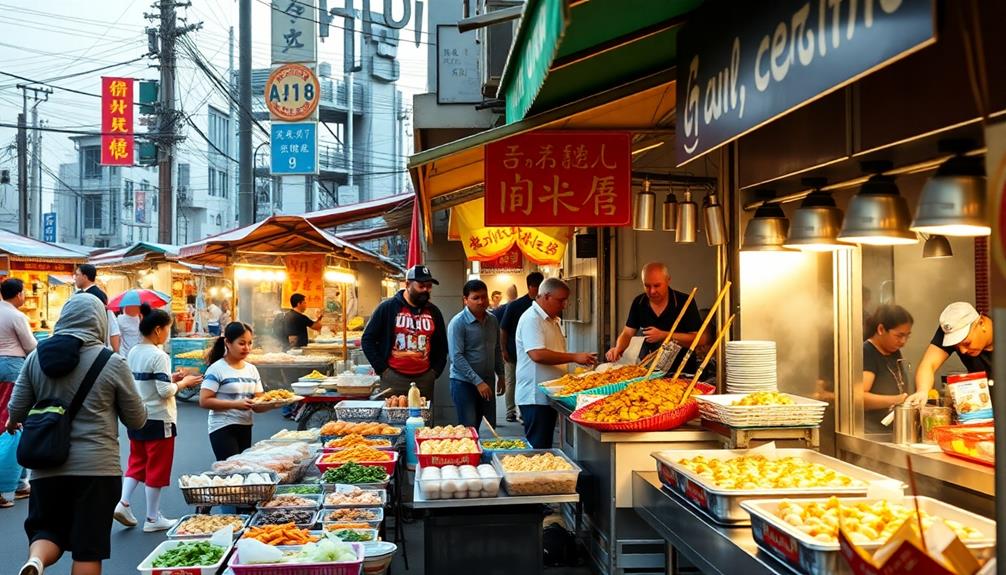
What makes street food such an essential part of local cultures around the globe? Street food culture thrives on the vibrant offerings that connect you to a region's heritage and community.
In Thailand, for example, you might encounter delightful treats like Khanom Tan, a traditional dessert that beautifully showcases local ingredients. With around 2.5 billion consumers indulging daily, it's clear that traditional street food plays a pivotal role in everyday life. These culinary delights often originate from recipes passed down through generations, allowing you to savor a unique culinary experience that reflects the soul of the area.
Originally catering to the working class, street food has evolved to attract a diverse demographic, embracing the growing demand for convenience and authenticity. You might find yourself enjoying a delicious banh mi in Vietnam or treating yourself to a French crepe in Europe—each dish tells a story of its cultural roots.
Despite facing challenges like financial instability and health risks, street food vendors remain steadfast in preserving this culinary heritage. Their resilience not only enriches your dining experience but also keeps local traditions alive.
Cultural Significance of Street Food
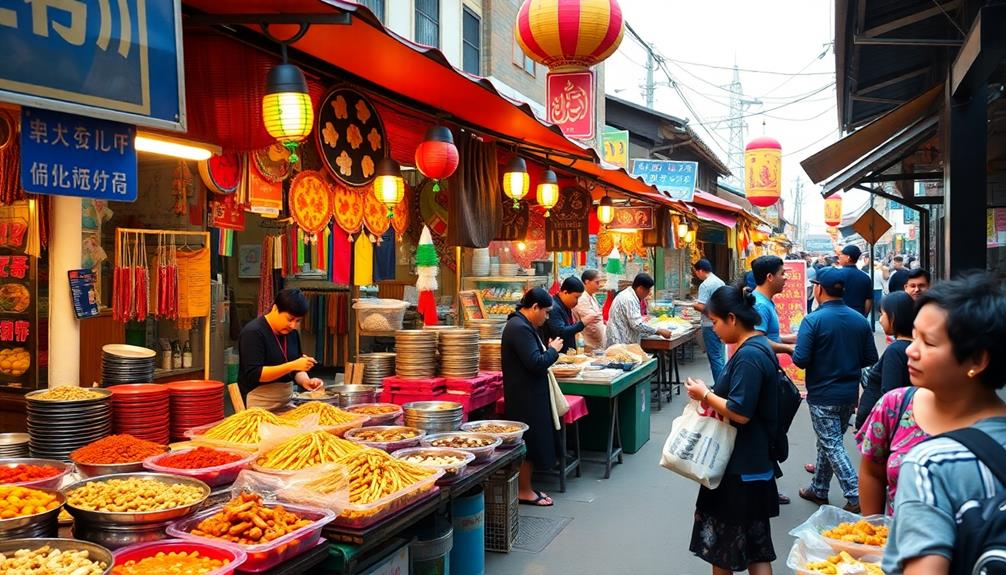
Street food isn't just about grabbing a quick bite; it's a celebration of cultural heritage that connects generations.
Dishes like Red-Braised Pork Belly or Sichuan Cold Noodles reflect the diverse flavors and cooking methods that define regional cuisines.
By enjoying these local dishes, you're participating in a rich tradition that emphasizes social equality, as people from all walks of life gather to share meals.
These vendors play an essential role in preserving culinary practices while adapting to modern challenges, making each dish a story worth savoring.
Cultural Heritage Preservation
Culinary traditions thrive in the vibrant world of street food, where vendors become guardians of their heritage, passing down cherished recipes through generations. This dynamic scene serves as a crucial means of cultural heritage preservation, particularly in cities like Delhi and Bangkok. Here, street food reflects deep cultural roots, conveying the stories and identities of the communities that create and consume it.
Street food offerings such as Mushroom Masala and Kathi Rolls not only delight the palate but also showcase the rich culinary landscape of their origins.
Consider the emotional weight of these culinary traditions:
- Family Recipes Passed: Each dish carries the essence of generations, steeped in family history.
- Cultural Identity: Street food vendors embody the spirit of their communities, showcasing local flavors and traditions.
- Symbol of Honor: In many societies, a vendor's stall stands as a symbol of their family's legacy and pride.
- Connection to Agriculture: Authentic street food emphasizes local ingredients, highlighting the importance of regional agricultural practices and their role in cultural expression.
Through the stories shared in the Netflix series "Street Food," we see how these personal narratives underscore the cultural significance of each dish, illustrating the profound connection between food, tradition, and community.
Social Equality Through Food
Food can serve as a powerful tool for social equality, breaking down barriers and creating shared experiences among people from different backgrounds. Street food plays an essential role in this by offering affordable meal options that everyone can enjoy, regardless of their socioeconomic status.
For instance, traditional Brazilian street foods like Coconut Candy can be enjoyed by people from all walks of life, showcasing the diverse culinary landscape of Brazil. When you grab a bite from a street vendor, you're not just satisfying your hunger; you're participating in a communal dining experience that fosters social bonds.
In cities like Istanbul, street vendors showcase ethnic diversity, serving dishes that reflect the culinary traditions of various communities, such as Armenian, Kurdish, and Turkish. This interconnectedness highlights how food can unite people.
Popular offerings like jollof rice in Nigeria or banh mi in Vietnam represent more than just meals; they symbolize cultural identity and pride.
Government initiatives also recognize the significance of street food in promoting social equality, supporting street vendors to enhance food security and uplift local economies.
Challenges for Street Vendors
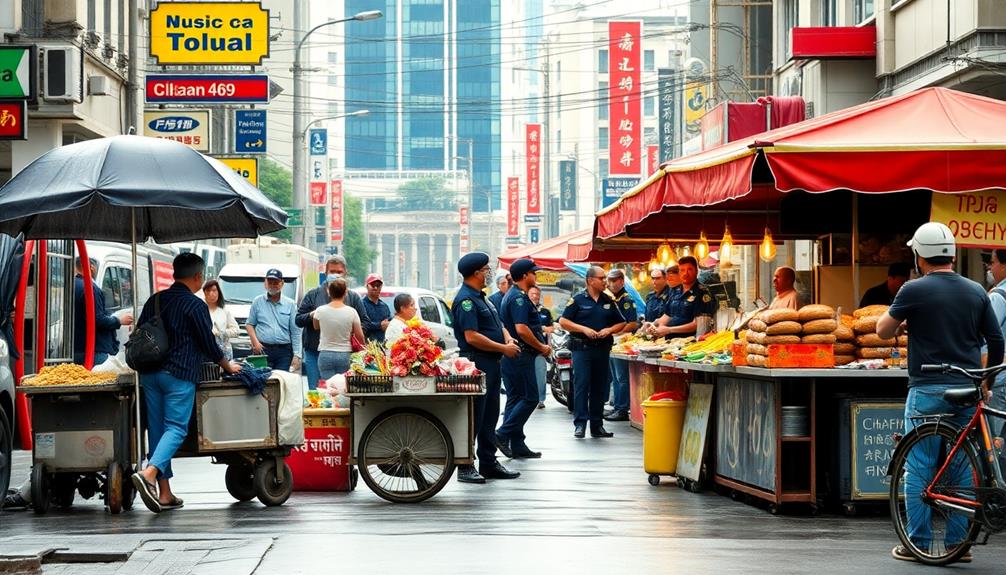
Steering through the world of street vending isn't easy, as vendors often grapple with financial instability and unpredictable regulations. Many rely on their passion for cooking rather than profit, making their business operations precarious.
Just like iconic street foods such as Dorayaki offer a sweet taste of cultural heritage, street vendors around the world contribute to their local culinary scene. Government regulations further complicate matters, with cities like Bangkok relocating over 20,000 vendors since 2016, jeopardizing their livelihoods.
The challenges street vendors face can be overwhelming:
- Poverty: Many live on the edge, struggling to make ends meet.
- Natural Disasters: These can wipe out their hard work in an instant.
- Family Separation: Long hours can take a toll, pulling families apart.
- Gender Inequality: Women vendors often face additional barriers, amplifying their struggles.
Despite these hurdles, street food vendors continue to play a crucial role in preserving cultural heritage and providing affordable meals to diverse communities.
Their resilience shines through, but the fight against financial instability and government regulations remains a formidable challenge. You can support these vendors by advocating for fair policies and appreciating the rich cultural tapestry they contribute to your community.
Evolution of Street Food Practices
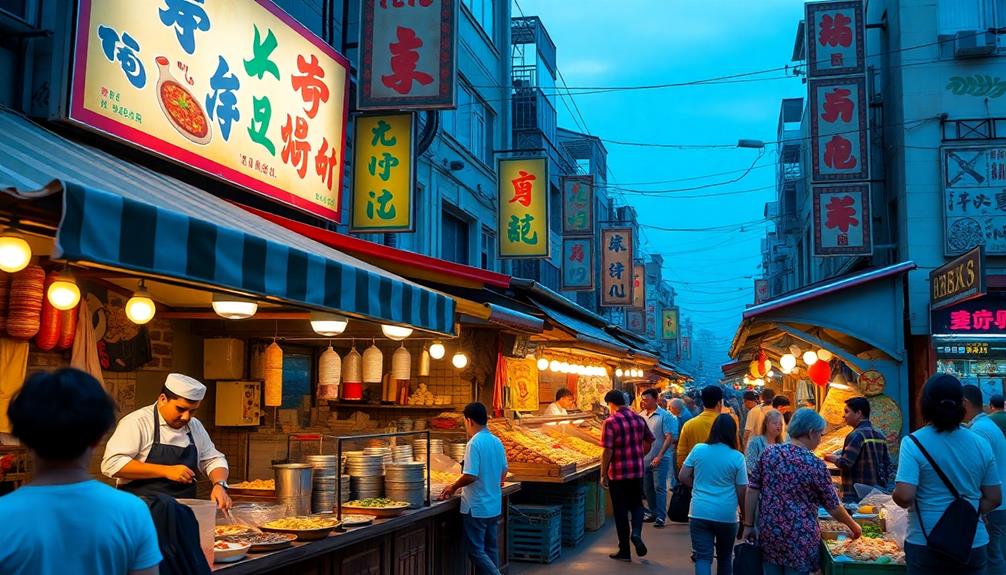
Street food practices have undergone a remarkable transformation over the years, blending tradition with modern trends. You'll notice that vendors are innovating dishes, adapting to local tastes while incorporating global influences.
In cities like Bangkok, the landscape has shifted dramatically, with over 20,000 vendors relocating since 2016 due to government regulations. This change impacts the availability and authenticity of traditional street food.
In Indonesia, for instance, popular street snacks like Kue Putu and Dadar Gulung reflect a rich heritage while continuing to delight modern palates with their unique flavors and textures.
Meanwhile, the rise of food trucks in North America and Europe has modernized the scene, introducing a fusion of global cuisines that caters to contemporary palates. These mobile kitchens offer everything from gourmet tacos to artisanal burgers, proving that street food can evolve while still honoring its roots.
Traditional vendors, like Mbah Satinem in Indonesia, exemplify this balance by preserving age-old recipes while embracing new culinary trends.
This dynamic between heritage and innovation is essential as globalization reshapes street food offerings. Unique fusions, such as fusion tacos, showcase how cultural exchanges can redefine what we think of as street food, making it an exciting and ever-evolving culinary experience that reflects the world around us.
Media Influence on Street Food
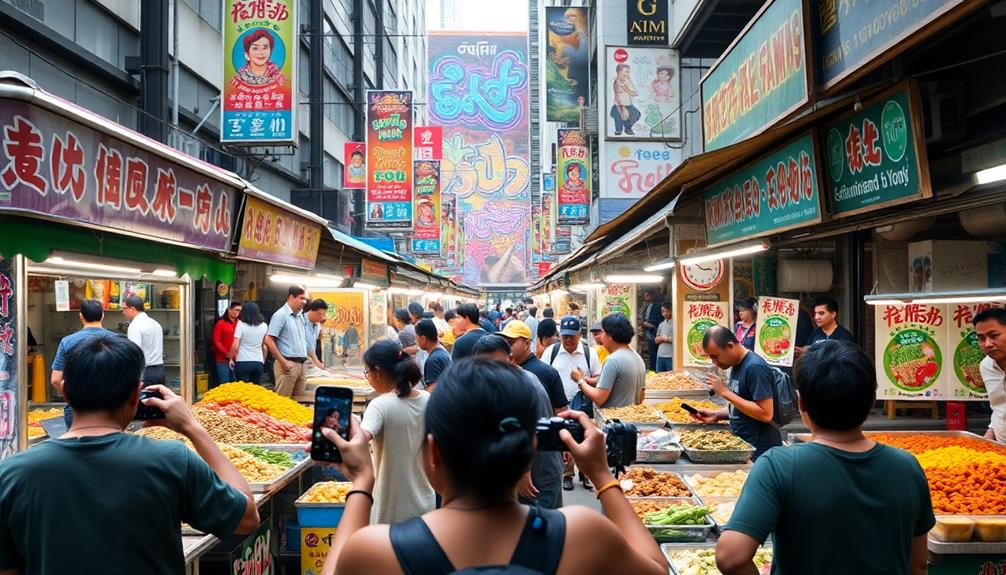
The influence of media on street food culture has been profound, transforming how people perceive and engage with this culinary tradition. Shows like Netflix's "Street Food" reveal the artistry and cultural significance of vendors, igniting a global passion for these dishes. Now, street food isn't just a quick bite; it's an experience that locals and tourists alike crave.
For instance, dishes like Chilaquiles showcase the creative use of local ingredients and offer a glimpse into traditional Mexican breakfast culture.
Consider these emotional connections that media fosters:
- Nostalgia: You're reminded of childhood memories tied to flavors and aromas.
- Cultural Representation: You discover authentic traditions from diverse regions.
- Community: You witness the bond between vendors and their neighborhoods, highlighting their struggles and triumphs.
- Celebration: You feel the excitement of street food festivals that bring people together over shared tastes.
Social media enhances this influence, showcasing visually stunning creations that entice you to try new flavors.
The portrayal of street food in documentaries raises awareness about the challenges vendors face and emphasizes the economic importance of their work. This media influence doesn't just elevate street food; it creates a vibrant community that celebrates culinary diversity.
Street Food in Asia
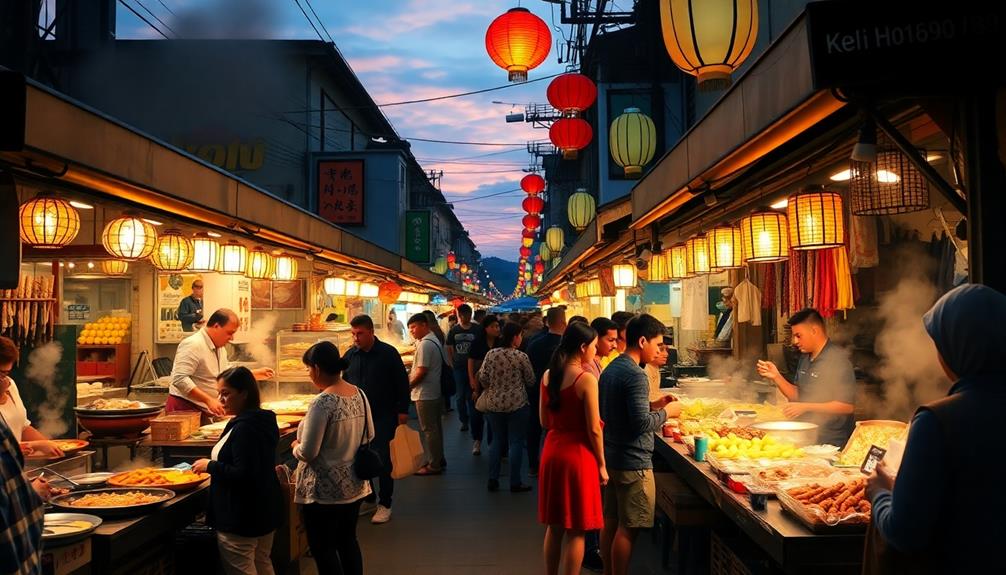
When you explore street food in Asia, you'll encounter a vibrant tapestry of culinary diversity that reflects rich traditions and cultural heritage.
From the savory aromas of grilled meats, reminiscent of Korean BBQ, to the colorful presentation of various dishes, this scene not only makes delicious meals accessible but also supports local economies and small businesses.
However, as you enjoy these flavors, it's crucial to recognize the challenges vendors face in preserving their livelihoods amidst regulatory pressures.
Culinary Diversity and Tradition
Culinary diversity thrives in Asia's vibrant street food scene, where traditions are woven into every dish.
You'll find that many vendors have inherited cherished recipes, reflecting a deep respect for culinary heritage. This connection to the past is palpable in bustling markets, where the aroma of local ingredients fills the air.
In Vietnam, the rich tapestry of flavors includes unique treats like Cylindrical Sticky Rice Cake and Banh Beo, showcasing the artistry of street food.
Here are a few highlights of Asia's street food culture that you won't want to miss:
- Banh Mi in Vietnam – A delightful fusion of French and Vietnamese flavors, showcasing fresh herbs and local meats.
- Aloo Chaat in India – A spicy, tangy potato snack that embodies the essence of Indian street cuisine.
- Night Markets in Taiwan – A feast for the senses, these bustling hubs are alive with colors, sounds, and flavors that bring people together.
- Food Stalls in Seoul – Offering everything from tteokbokki to kimchi pancakes, these stalls provide a taste of Korean culinary traditions.
As you explore Asia's street food, you'll not only savor the flavors but also experience the communal spirit that binds diverse communities through shared meals.
Economic Impact and Accessibility
Street food in Asia not only tantalizes your taste buds but also serves as an essential economic engine for local communities. It provides affordable meal options for the working class, allowing them to enjoy diverse cuisines without breaking the bank.
In bustling markets across Thailand and Vietnam, vendors serve up delicious dishes that draw both locals and tourists, creating a vibrant atmosphere that fuels tourism and fosters cultural exchange. The variety of flavors and textures, reminiscent of classic American comfort foods like a Loaded Baked Potato, showcases the adaptability and creativity of street food vendors.
The economic impact of street food is profound, as these vendors typically operate with minimal overhead costs. This enables them to offer competitive prices, making their fare accessible to a wider demographic. By sustaining small businesses, street food contributes considerably to urban livelihoods and supports thousands of families.
Moreover, the rise of food trucks and modern street food concepts in cities like Seoul and Singapore highlights the adaptability of this culinary tradition. As consumer preferences evolve, street food continues to thrive, proving its relevance in urban economies.
Cultural Heritage Preservation
Food culture in Asia thrives through the vibrant tapestry of street vendors who not only serve meals but also preserve centuries-old culinary traditions.
These vendors are custodians of cultural heritage, passing down recipes and techniques that reflect deep familial and regional ties. When you savor a bowl of pho in Hanoi or a plate of pad thai in Bangkok, you're tasting the essence of community histories and traditional practices.
Here are four reasons why street food is essential for heritage preservation:
- Authenticity: Street vendors showcase dishes made from local ingredients, ensuring culinary authenticity.
- Generational Knowledge: Many recipes are inherited, keeping traditional cooking methods alive.
- Community Bonds: Meals are often shared, reinforcing social connections and cultural continuity.
- Cultural Identity: Vendors represent the heart of their communities, embodying local customs and traditions.
Government initiatives support these crucial preservers of culinary legacy, recognizing their role amid modernization pressures.
Street Food in Europe
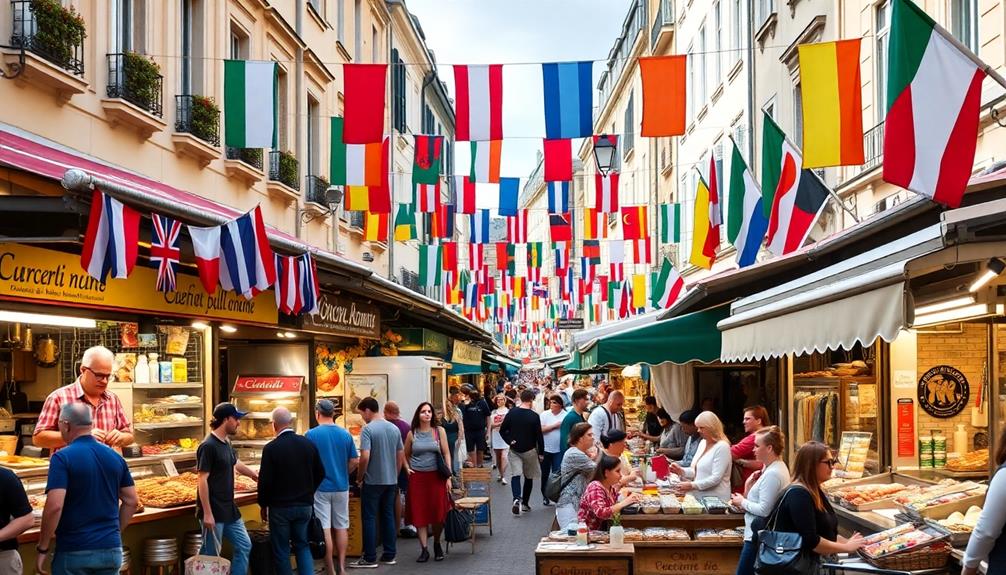
Across Europe, the vibrant street food scene has transformed how people experience dining. Food trucks have modernized traditional street food, blending global cuisines and offering diverse culinary options at festivals and events. You'll find everything from French crepes to Italian calzones and Belgian pommes frites, showcasing regional culinary traditions that appeal to both locals and tourists alike.
The rise of food trucks responds to the demand for convenient dining, providing a tasty alternative to traditional restaurants while supporting local businesses. At bustling markets and lively festivals, street food vendors create an inviting social atmosphere, encouraging culinary experimentation.
You can taste innovative dishes that reflect the creativity of chefs enthusiastic to push the boundaries of street food. As you explore the streets of Europe, you'll discover that the revitalization of street food culture not only celebrates heritage but also invites you to enjoy unique flavors and experiences.
Whether grabbing a quick bite or enjoying a leisurely meal outdoors, the street food scene enhances your dining experience, making each outing an exciting culinary adventure.
Street Food in Latin America
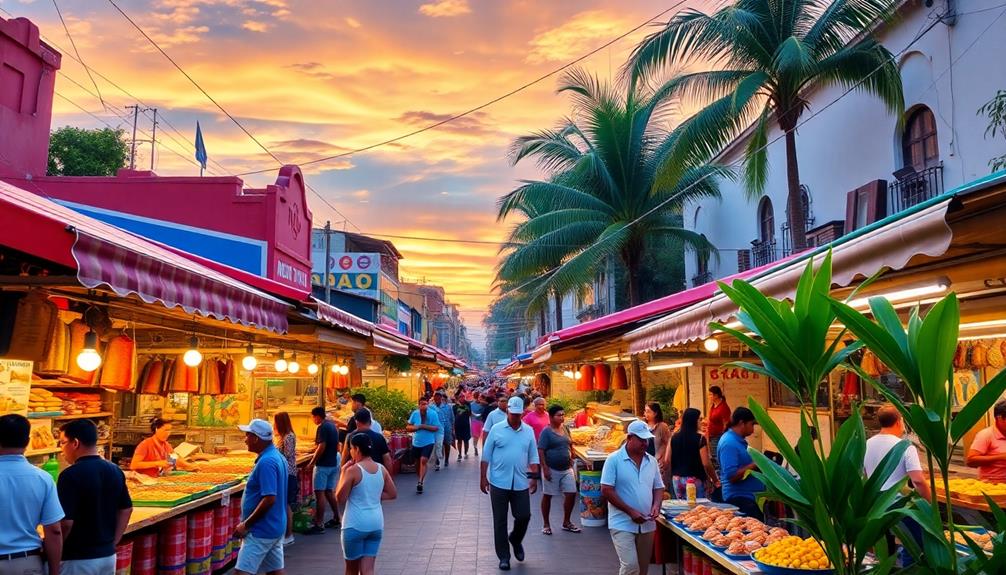
In Latin America, the vibrant street food culture reflects a rich tapestry of flavors and traditions. This culinary scene showcases a long-standing tradition with recipes passed down through generations, highlighting the region's diverse cuisine.
You'll find popular street food items like:
- Arepas in Venezuela – delicious cornmeal cakes stuffed with a variety of fillings.
- Ceviche in Peru – a revitalizing dish of fresh raw fish marinated in zesty citrus juices.
- Tacos in Mexico – filled with an array of meats, vegetables, and salsas that burst with flavor.
- Empanadas in Argentina – savory pastries that can be filled with meats, cheeses, or vegetables.
Food trucks have surged in city centers and festivals, making traditional dishes and innovative creations easily accessible.
In places like Mexico City, food truck parks let you sample a diverse array of street food in one spot, transforming dining into a social gathering experience.
Street food in Latin America isn't just about affordability and convenience; it's about connecting with friends and family over shared meals, making every bite a celebration of culture and community.
Street Food in North America
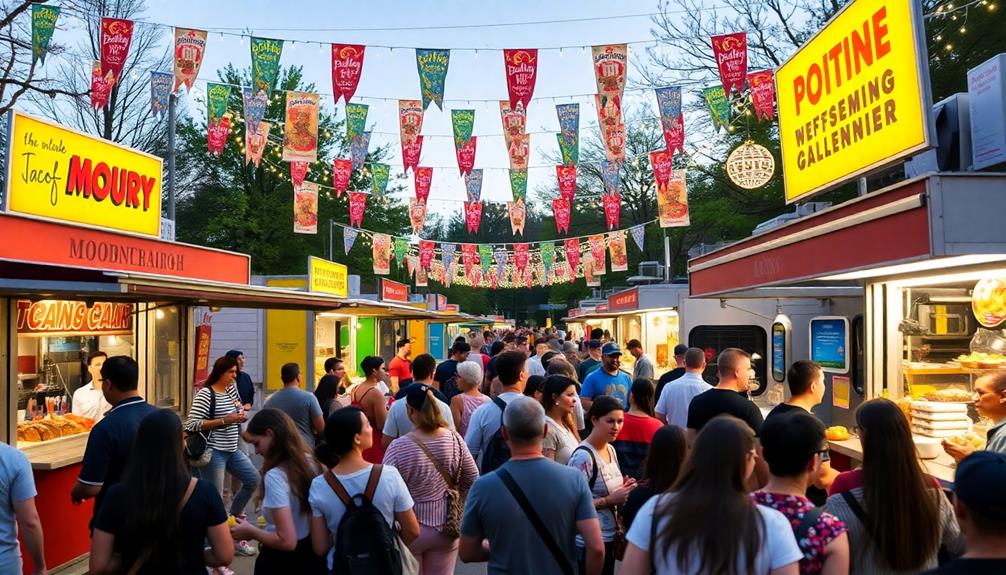
What makes street food in North America so exciting is its incredible variety and fusion of flavors. The street food scene is a vibrant tapestry woven from different regions, showcasing a wide variety of dishes that reflect global influences.
You'll find enticing options like Korean BBQ tacos and gourmet grilled cheese sandwiches that blend culinary traditions in delicious ways.
Food trucks have surged in popularity, often parked at festivals and parks, bringing communities together while offering diverse culinary experiences. These mobile kitchens not only satisfy cravings but also promote sustainability by prioritizing locally sourced ingredients.
Many vendors are committed to quality, ensuring you're savoring fresh, flavorful meals.
Moreover, a growing number of food trucks and street vendors support charitable causes, donating a portion of their profits to local organizations. This adds a meaningful layer to your dining experience, knowing that your meal contributes to the community.
As a local or tourist, indulging in North America's street food isn't just about the food; it's about the unique stories and connections that each dish represents.
Street Food in Africa
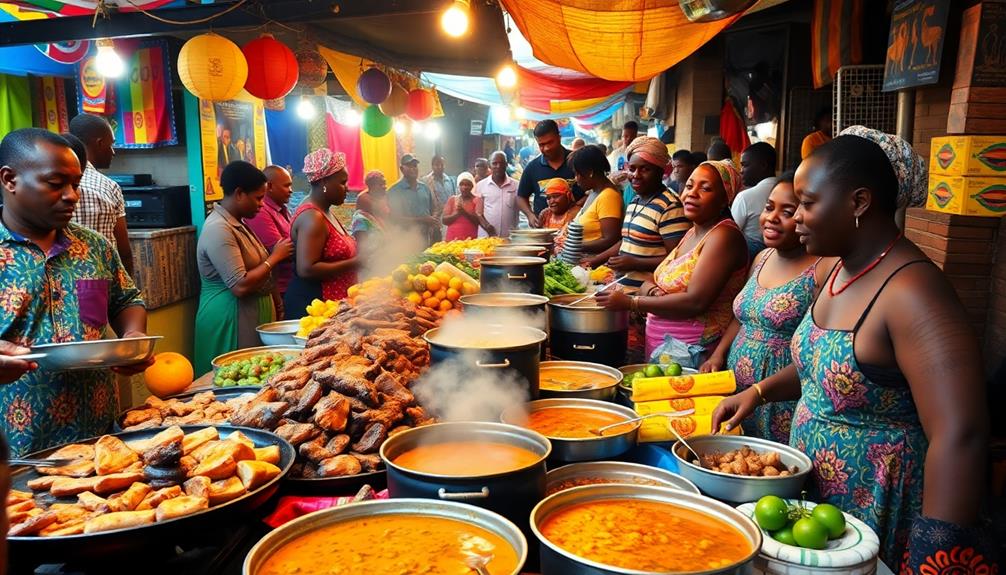
Street food in Africa bursts with flavor and cultural significance, offering a delightful array of dishes that reflect the continent's rich culinary traditions. You can savor iconic street foods like jollof rice in Nigeria and bunny chow in South Africa, each telling a story of its cultural heritage.
Food vendors play an essential role, using local ingredients to guarantee authenticity and affordability, making these meals accessible to everyone.
Here are some reasons why street food in Africa is truly special:
- Cultural Connection: Each dish showcases the unique flavors of its region, bridging generations and communities.
- Social Experience: Street food brings people together, creating lively gatherings filled with laughter and shared meals.
- Economic Impact: Food vendors support local economies, providing jobs and guaranteeing food security for many families.
- Culinary Adventure: You can explore vibrant street food markets in cities like Cape Town and Lagos, where every bite is a taste of African cuisine.
With every dish, you're not just eating; you're experiencing the heart and soul of Africa, one flavorful bite at a time.
Frequently Asked Questions
How Does Culture Affect Street Food?
Culture shapes street food by influencing ingredients, cooking methods, and flavors. You'll find local tastes reflected in each dish, as vendors blend traditions, making every bite a unique experience that connects you to the community.
What Is the Cultural Significance of Street Food Around the World?
You might think street food's just quick bites, but it's a cultural tapestry, weaving together traditions and identities. Each dish tells a story, connecting people across generations and transforming casual meals into shared experiences.
How Does Food Connect With Different Cultures?
Food connects you with different cultures by showcasing unique ingredients, flavors, and cooking techniques. It invites you to share experiences, learn traditions, and appreciate diversity, creating bonds that transcend language and background through communal dining.
What Is the Multi Cultural Approach to Food?
Isn't it fascinating how food brings people together? You'll find that each culture infuses its identity into dishes, celebrating unique flavors and traditions, creating a vibrant tapestry that connects diverse communities through shared culinary experiences.
Conclusion
As you stroll through bustling markets, the aroma of grilled skewers mingles with sweet churros, a delicious coincidence that highlights street food's vibrant tapestry. Each bite tells a story, connecting you to cultures around the globe. From the lively streets of Bangkok to the colorful stalls in Mexico City, street food isn't just a meal; it's an experience that unites us all. So next time you savor a taco or dim sum, remember the rich heritage behind it.




